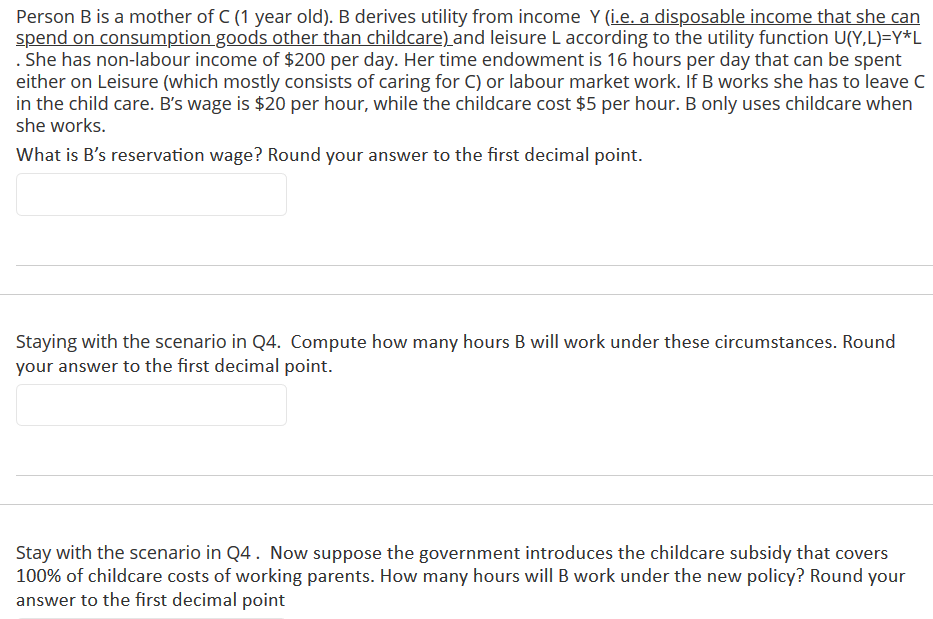Person B is a mother of C (1 year old). B derives utility from income Y (i.e. a disposable income that she can spend on consumption goods other than childcare) and leisure L according to the utility function U(Y,L)=Y*L . She has non-labour income of $200 per day. Her time endowment is 16 hours per day that can be spent either on Leisure (which mostly consists of caring for C) or labour market work. If B works she has to leave c in the child care. B's wage is $20 per hour, while the childcare cost $5 per hour. B only uses childcare when she works. What is B's reservation wage? Round your answer to the first decimal point. Staying with the scenario in Q4. Compute how many hours B will work under these circumstances. Round your answer to the first decimal point. Stay with the scenario in Q4. Now suppose the government introduces the childcare subsidy that covers 100% of childcare costs of working parents. How many hours will B work under the new policy? Round your answer to the first decimal point
Person B is a mother of C (1 year old). B derives utility from income Y (i.e. a disposable income that she can spend on consumption goods other than childcare) and leisure L according to the utility function U(Y,L)=Y*L . She has non-labour income of $200 per day. Her time endowment is 16 hours per day that can be spent either on Leisure (which mostly consists of caring for C) or labour market work. If B works she has to leave c in the child care. B's wage is $20 per hour, while the childcare cost $5 per hour. B only uses childcare when she works. What is B's reservation wage? Round your answer to the first decimal point. Staying with the scenario in Q4. Compute how many hours B will work under these circumstances. Round your answer to the first decimal point. Stay with the scenario in Q4. Now suppose the government introduces the childcare subsidy that covers 100% of childcare costs of working parents. How many hours will B work under the new policy? Round your answer to the first decimal point
Chapter4: Utility Maximization And Choice
Section: Chapter Questions
Problem 4.14P
Related questions
Question
solve this all these three subparts early i upvote

Transcribed Image Text:Person B is a mother of C (1 year old). B derives utility from income Y (i.e. a disposable income that she can
spend on consumption goods other than childcare) and leisure L according to the utility function U(Y,L)=Y*L
. She has non-labour income of $200 per day. Her time endowment is 16 hours per day that can be spent
either on Leisure (which mostly consists of caring for C) or labour market work. If B works she has to leave c
in the child care. B's wage is $20 per hour, while the childcare cost $5 per hour. B only uses childcare when
she works.
What is B's reservation wage? Round your answer to the first decimal point.
Staying with the scenario in Q4. Compute how many hours B will work under these circumstances. Round
your answer to the first decimal point.
Stay with the scenario in Q4. Now suppose the government introduces the childcare subsidy that covers
100% of childcare costs of working parents. How many hours will B work under the new policy? Round your
answer to the first decimal point
Expert Solution
This question has been solved!
Explore an expertly crafted, step-by-step solution for a thorough understanding of key concepts.
This is a popular solution!
Trending now
This is a popular solution!
Step by step
Solved in 3 steps with 12 images

Knowledge Booster
Learn more about
Need a deep-dive on the concept behind this application? Look no further. Learn more about this topic, economics and related others by exploring similar questions and additional content below.Recommended textbooks for you

